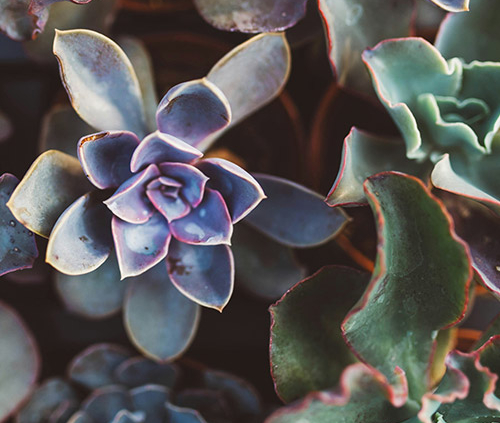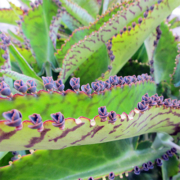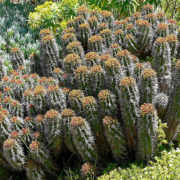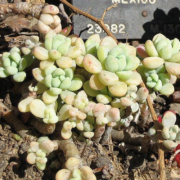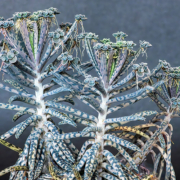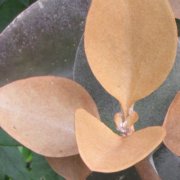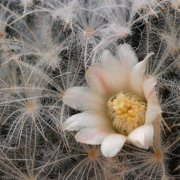Colorful Succulents: A 🌈Rainbow of Vibrant Choices for Your Garden
Colorful Succulents: A 🌈Rainbow of Options for Your Garden
Succulents are not just green ya know… they come in an amazing array of colors that can transform any garden into a vibrant, living rainbow. Whether you’re drawn to the fiery reds of Echeveria ‘Fireball’ or the cool blues of Blue Chalksticks, there’s a succulent to match every hue you love.
In this article, we’ll explore some of the most colorful succulents and how to use them to create a stunning garden display. 😁
A Rainbow of Succulents
Succulents are known for their water-storing leaves and low-maintenance nature, but did you know they also come in almost every color imaginable? Let’s dive into the colorful world of succulents and discover how each hue can add a unique charm to your garden.
❤️Red: Fiery and Bold
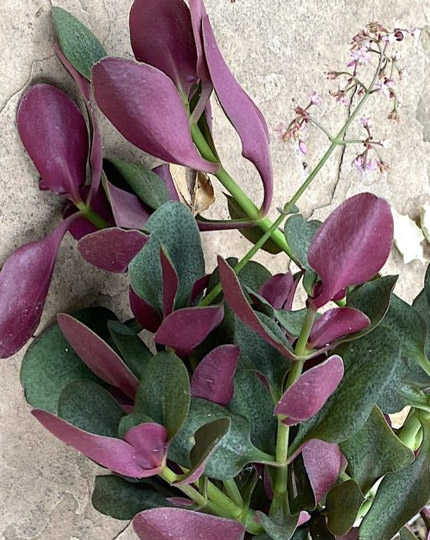
Red Fairy Crassula succulent plant, image by debraleebaldwin.com
Red succulents are a vibrant addition to any garden, instantly catching the eye with their rich, fiery hues. These plants aren’t just about color—they bring a sense of energy and passion to your outdoor or indoor spaces, making them an excellent choice for anyone looking to make a bold statement.
Among the many varieties of red succulents, a couple of standout options are worth considering.
Echeveria ‘Fireball’
The Echeveria Fireball is a stunning succulent that lives up to its name. This plant forms beautiful rosettes with leaves that turn a bright, intense red when exposed to full sunlight.
The color is not only vibrant but also changes subtly with the seasons and light conditions, adding dynamic interest to your garden. Its compact size makes it perfect for container gardens, rock gardens, or as a focal point in a succulent arrangement.
With the ‘Fireball,’ your garden gains a burst of fiery energy that’s sure to draw attention.
Echeveria ‘Red Velvet’
For those who appreciate unique textures as much as bold colors, the Echeveria Red Velvet is a must-have. This variety stands out with its deep red, velvety leaves, which are covered in tiny, soft hairs.
These fuzzy leaves not only add a striking visual contrast but also bring a tactile element to your succulent collection. The Red Velvet thrives in well-drained soil and plenty of sunlight, where its deep red tones are most pronounced.
It’s a perfect choice for anyone looking to introduce both color and texture into their garden.
Other red succulents include:
- Sedum rubrotinctum ‘Aurora’ (Jelly Bean Plant)
- Crassula capitella ‘Campfire’
- Aloe ‘Christmas Carol’
- Echeveria agavoides ‘Lipstick’
- Kalanchoe luciae (Paddle Plant)
- Echeveria ‘Red Taiga’
- Sedum nussbaumerianum
🧡Orange: Warm and Inviting
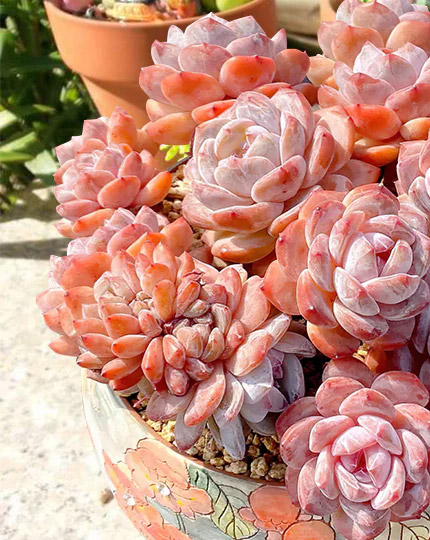
Echeveria Monroe succulent plant, image by thenextgardener.com
Orange succulents infuse a space with warmth and charm, creating an inviting atmosphere that feels cozy and welcoming. Their vibrant hues evoke the colors of a sunset, bringing a sense of tranquility and comfort to any garden or indoor display.
One of the most captivating orange succulents is the versatile and ever-changing Graptoveria Fred Ives.
Graptoveria ‘Fred Ives’
The Graptoveria Fred Ives is a stunning hybrid succulent that showcases a mesmerizing array of colors, with its leaves shifting between shades of orange, pink, and yellow. The color intensity and variation are influenced by the amount of sunlight the plant receives, making it a dynamic addition to any collection.
In bright, direct sunlight, the leaves take on a rich, fiery orange hue, while in slightly shaded areas, they may display softer tones of pink and yellow. This seasonal color change adds an element of surprise and delight, ensuring that your garden is always evolving.
Sedum nussbaumerianum
Another standout orange succulent is Sedum nussbaumerianum, commonly known as Coppertone Stonecrop. This beautiful succulent is known for its elongated leaves that develop a warm, coppery-orange color when grown in full sun.
The plant forms dense rosettes, making it an excellent choice for ground cover, container gardens, or as part of a mixed succulent arrangement. As a bonus, it produces small, star-shaped white flowers that add to its charm, typically blooming in late winter or early spring.
The vibrant orange tones of Sedum nussbaumerianum make it a perfect plant to brighten up any space with a touch of warmth.
More orange succulents include:
- Echeveria ‘Orange Monroe’
- Kalanchoe blossfeldiana
- Aloe brevifolia aka Short-Leaved Aloe
- Aloe ‘Crosby’s Prolific’
- Kalanchoe delagoensis aka Mother of Millions
- Echeveria ‘Orange Dream’
- Graptosedum ‘California Sunset’
- Echeveria ‘Tangerine’
- Aloe arborescens ‘Sunset’
💛Yellow: Bright and Cheerful
Yellow succulents are like little rays of sunshine in your garden, bringing a burst of brightness and cheer wherever they’re planted. Their vibrant color adds a lively contrast to the greens and other hues in your succulent collection, making them perfect for brightening up any space.
Among the popular choices for yellow succulents, two stand out for their beauty and resilience.
Sedum adolphii (Golden Sedum)
Sedum adolphii, commonly known as Golden Sedum, is a charming succulent that showcases golden-yellow leaves, making it a delightful and eye-catching addition to any garden. When exposed to full sunlight, the leaves can develop a hint of reddish tones at the tips, adding a lovely gradient effect to the plant’s overall appearance.
This succulent is not only visually appealing but also easy to care for, thriving in well-drained soil and plenty of sunlight. It’s an excellent choice for rock gardens, container arrangements, or as a ground cover, where its cheerful color can truly shine.
Crassula ovata ‘Hummel’s Sunset’ (Golden Jade Tree)
Another beautiful yellow succulent is Crassula ovata Hummel’s Sunset, also known as the Golden Jade Tree. This succulent is celebrated for its rounded, fleshy leaves that exhibit stunning shades of yellow, gold, and green.
When exposed to bright light, the leaf edges develop a reddish hue, resembling the colors of a sunset, hence its name. As it matures, Hummel’s Sunset can grow into a small, tree-like shrub, making it a standout feature in any garden or indoor space.
It’s a hardy plant that’s easy to grow, adding both color and structure to your succulent collection.
Other bright and cheerful succulents include:
- Echeveria ‘Golden Glow’
- Crassula ovata ‘Hummel’s Sunset’ (Golden Jade)
- Sedum lineare ‘Variegatum’
- Sedum praealtum aka Shrubby Stonecrop
- Graptopetalum paraguayense ‘Ghost Plant’ (when sun-stressed)
- Sedum makinoi ‘Ogon’
- Opuntia engelmannii var lindheimeri aka Texas Pricklypear
- Aloe ‘Yellow Snow’
- Aeonium ‘Sunburst’
- Kalanchoe blossfeldiana (Yellow Varieties)
💚Green: Classic and Refreshing
Green is the quintessential color of nature, and when it comes to succulents, green varieties offer a timeless appeal that never goes out of style. They bring a sense of freshness and tranquility to any garden or indoor space, and with such a wide variety to choose from, you can easily find the perfect green succulent to suit your needs.
Here are two classic green succulents that are not only beautiful but also offer unique benefits.
Aloe Vera
Aloe Vera is a well-loved green succulent, known not only for its aesthetic appeal but also for its numerous medicinal properties. With its fleshy, lance-shaped leaves arranged in a rosette pattern, Aloe Vera adds a lush, tropical feel to any garden or home.
The leaves are a vibrant green, often tinged with subtle shades of blue or grey, and are edged with soft, serrated teeth. Beyond its beauty, Aloe Vera is a valuable plant to have on hand, as the gel inside its leaves is renowned for its soothing and healing properties, especially for burns and skin irritations.
Aloe Vera thrives in bright, indirect sunlight and well-drained soil, making it a low-maintenance, multifunctional addition to your succulent collection.
Haworthia Species
The Haworthia genus includes a variety of small, spiky succulents that come in many shades of green, each with its own unique pattern and texture. These compact plants are perfect for adding visual interest and diversity to your collection.
Whether it’s the translucent, windowed leaves of Haworthia cooperi or the striped, zebra-like patterns of Haworthia fasciata, these succulents offer a refreshing pop of green that complements any setting. Haworthias are incredibly resilient and adaptable, thriving in low to bright indirect light, which makes them ideal for indoor growing.
Their textured, geometric forms bring a touch of natural elegance to small spaces, making them a favorite among succulent enthusiasts.
More classic green succulents include:
- Echeveria ‘Green Pearl’
- Sedum morganianum (Burro’s Tail)
- Haworthia attenuata (Zebra Plant)
- Kalanchoe tomentosa aka 🐼 Panda Plant
- Agave attenuata (Fox Tail Agave)
- Graptopetalum paraguayense (Ghost Plant)
- Aeonium arboreum
- Portulacaria afra (Elephant Bush)
💙Blue: Cool and Tranquil
Blue succulents bring a sense of calm and serenity to any space, evoking the peacefulness of a clear sky or a calm sea. Their cool tones are perfect for creating a relaxing atmosphere and can beautifully complement warmer colors in your garden or home.
Here are a couple of notable blue-hued succulents that can add that tranquil vibe to your collection.
Blue Chalksticks (Senecio serpens)
Blue Chalksticks (Senecio serpens) is a stunning succulent known for its slender, powdery blue leaves that grow upright in clusters, resembling delicate sticks of chalk. This succulent’s unique color and shape make it an excellent choice for adding a cool, modern touch to any garden or container arrangement.
It’s particularly striking when planted alongside warmer-toned succulents, as the blue leaves create a striking contrast that enhances the beauty of both. Blue Chalksticks thrive in full sun to partial shade and are highly drought-tolerant, making them a hardy option for outdoor gardens, especially in rock gardens or as ground cover.
Blue Echeveria
The Blue Echeveria is a beloved succulent that includes several species and hybrids with a bluish tint to their rosettes, particularly when grown in bright light. Species like Echeveria ‘Blue Atoll’ and Echeveria ‘Perle von Nurnberg’ showcase beautiful blue-green leaves, often edged with hints of pink or purple, creating a soft and soothing color palette.
These succulents are perfect for adding a cool, calming element to your garden or indoor space. The symmetrical rosettes of Blue Echeveria can be planted in groups to create a harmonious, serene display or used as a focal point in mixed succulent arrangements.
They thrive in well-drained soil with plenty of sunlight, ensuring their blue hues remain vibrant and eye-catching.
These are some of my favorite blueish plants:
- Echeveria ‘Blue Atoll’
- Agave parryi truncata aka Artichoke Agave
- Agave tequilana (Blue Agave)
- Sedum ‘Blue Pearl’
- Echeveria ‘Blue Prince’
- Sedum clavatum
- Agave ‘Blue Glow’
- Sedeveria ‘Blue Elf’
- Senecio serpens aka Blue Chalksticks
💜Purple: Regal and Sophisticated
Purple succulents bring an air of elegance and mystery to any garden, infusing your space with a regal and sophisticated vibe. Their unique color, ranging from deep violet to soft lavender, adds depth and interest to succulent arrangements, making them a favorite for those looking to elevate their garden’s aesthetic.
Two standout purple succulents that embody this sense of sophistication are Echeveria ‘Perle von Nurnberg’ and Graptoveria ‘Opalina’.
Echeveria ‘Perle von Nurnberg’
Echeveria Perle von Nurnberg is a striking succulent, highly regarded for its rosettes of purple-pink leaves, which are covered in a soft, powdery coating as shown in great detail at Epic Gardening. This powder gives the plant a unique, pearlescent finish, enhancing its visual appeal.
The leaves often take on a gradient of colors, with hints of lavender, pink, and occasionally blue, depending on the lighting conditions. Under bright light, these colors become more intense, making the Perle von Nurnberg a stunning focal point in any succulent arrangement.
In addition to its beauty, this variety is easy to care for, thriving in well-draining soil and bright, indirect sunlight. It also produces delicate coral-pink flowers on tall stems during the summer, further adding to its allure.
Graptoveria ‘Opalina’
Graptoveria Opalina is another exquisite purple succulent that captivates with its soft lavender hues. This hybrid succulent has plump, smooth leaves that form a rosette, and its color can shift from a gentle lavender to a more vibrant purple depending on sun exposure.
In bright light, Opalina may also develop pink or orange tinges at the edges of its leaves, adding to its romantic and dreamy appearance. This succulent is not only visually pleasing but also resilient and easy to maintain, making it an excellent choice for both novice and experienced gardeners.
Like the Perle von Nurnberg, it prefers well-draining soil and plenty of sunlight, ensuring that its colors remain vibrant and its growth healthy.
Purple succulents are very popular, here’s a few others:
- Echeveria ‘Perle von Nurnberg’
- Graptoveria ‘Opalina’
- Opuntia macrocentra aka Black-Spined Pricklypear
- Graptopetalum amethystinum (Lavender Pebbles)
- Sedum spathulifolium ‘Purpureum’
- Xerophyta retinervis
- Graptopetalum paraguayense ‘Superbum’
- Sedum ‘Purple Emperor’
🩷Pink: Soft and Playful
Pink succulents bring a whimsical and playful vibe to any garden or indoor arrangement, adding a splash of soft color that can brighten up your space. Their charming hues range from pale pink to deeper rose tones, making them a delightful choice for anyone looking to create a lively, joyful atmosphere.
Here are two pink succulents that are sure to enchant you.
Anacampseros rufescens
Anacampseros rufescens is a small but striking succulent known for its ability to display a vibrant range of colors, including a beautiful pink when exposed to bright light. This succulent forms low-growing rosettes, with fleshy leaves that can vary from green to deep pink or even purple, depending on its growing conditions.
The leaves often have a slight sheen, adding to their allure. Anacampseros rufescens is particularly charming in group plantings or as part of a succulent arrangement, where its colors can truly shine.
This plant is also relatively easy to care for, thriving in well-draining soil and bright, indirect light.
Sedum rubrotinctum ‘Aurora’ (Pink Jelly Beans)
Another playful pink succulent to consider is Sedum rubrotinctum Aurora, commonly known as Pink Jelly Beans. This succulent gets its name from its plump, jelly bean-shaped leaves that blush a beautiful pink in bright sunlight.
The leaves are typically a mix of pink and green, creating a fun and colorful display that adds a touch of whimsy to any garden or indoor pot. Like other Sedums, Aurora is low-maintenance, thriving in well-draining soil with minimal watering, and it’s also known for being an excellent ground cover or container plant.
Who doesn’t love these pink succulents?! 🫶
- Graptopetalum paraguayense ‘Pinky’
- Sedum sieboldii aka October Daphne
- Crassula pellucida variegata (Calico Kitten)
- Graptoveria ‘Debbie’
- Kalanchoe fedtschenkoi aka Lavender Scallops
Tips for Caring for Colorful Succulents
Caring for colorful succulents isn’t much different from caring for their green counterparts, but there are a few tips to keep in mind to maintain their vibrant hues:
- Sunlight: Most colorful succulents need plenty of sunlight to maintain their bright colors. However, be cautious of too much direct sun, which can cause sunburn.
- Watering: Like all succulents, these colorful varieties prefer well-draining soil and infrequent watering. Overwatering can lead to root rot.
- Temperature: These plants generally thrive in warm conditions. Protect them from frost and extreme cold, which can damage the plants.
Creating a Rainbow Garden
Now that you know about the various colors of succulents, let’s talk about arranging them to create a visually stunning garden:
- Contrast and Complement: Use contrasting colors to make each succulent stand out. For example, place a bright red Echeveria next to a cool blue Chalksticks for a striking effect.
- Gradation: Create a gradient effect by arranging succulents in a rainbow sequence. Start with red, followed by orange, yellow, green, blue, purple, and pink.
- Texture and Height: Vary the textures and heights of the plants to add depth and interest. Use tall, spiky plants like Aloe Vera alongside rosette-forming succulents like Echeveria.

